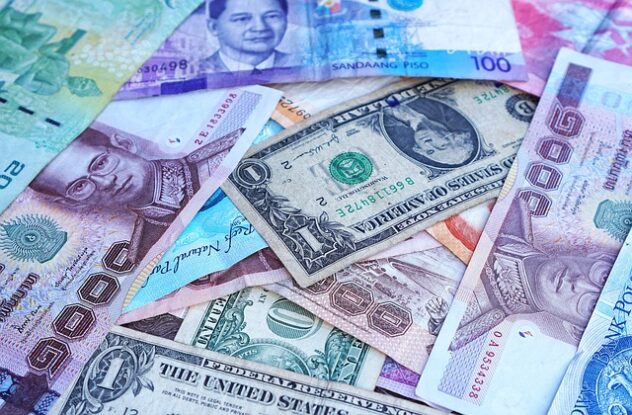The foreign exchange market, often referred to as the forex or currency market, is a dynamic and ever-evolving arena where the values of different currencies are constantly fluctuating against one another. Among the countless currency pairs traded globally, the Indian rupee (INR) and the US dollar (USD) hold significant importance, given the economic clout of both nations and their extensive trade relations.
In this intricate world of forex trading, even the slightest movements in exchange rates can have far-reaching implications for businesses, investors, and economies alike. Against this backdrop, the recent flat opening of the rupee against the US dollar in early trade has garnered attention from market participants and analysts.
Factors Influencing the Rupee’s Movement
As the trading session commenced, the rupee exhibited a relatively stable stance against the mighty greenback, opening without any significant gains or losses. This flat start can be attributed to many global and domestic factors that collectively shape the intricate dynamics of currency valuations.
While the rupee’s performance may appear uneventful at first glance, a closer examination reveals the delicate interplay of various economic and geopolitical forces that ultimately dictate the trajectory of this crucial currency pair.
Factors such as international trade dynamics, investor sentiment, monetary policy divergences, geopolitical tensions, and the relative strength of the respective economies can all contribute to the rupee’s fluctuations against the US dollar, even during periods of apparent calm. Market analysts and forex traders closely monitor these variables, as they can potentially trigger shifts in currency valuations, presenting both risks and opportunities
Global Factors Impacting the Rupee
The strength of the US dollar, often considered a barometer of global economic health, exerts a profound influence on the rupee’s valuation. A robust dollar, fueled by factors such as robust economic growth, hawkish monetary policies, or safe-haven demand during periods of uncertainty, can put downward pressure on the rupee’s value. Conversely, a weakening dollar can provide respite to the Indian currency.
Fluctuations in international crude oil prices, a critical import for India’s energy needs, can significantly impact the country’s trade balance and, consequently, the rupee’s exchange rate. Lastly, trends in other major currencies, particularly those of India’s key trading partners, can have a ripple effect on the rupee’s performance.
The US dollar’s dominance in global trade and finance means that its strength or weakness can have far-reaching implications for other currencies, including the rupee. As such, forex traders and market analysts closely monitor economic indicators, policy decisions, and geopolitical events that could potentially impact the greenback’s value, as these ripples can quickly translate into movements in the rupee-dollar exchange rate.
Domestic Catalysts Shaping The Rupee’s Value
On the domestic front, India’s economic growth prospects play a pivotal role in shaping the rupee’s trajectory. Robust economic expansion, driven by factors such as rising consumer demand, increased investment, and favorable policy reforms, can bolster investor confidence and strengthen the rupee’s appeal. Conversely, sluggish growth or economic uncertainties may weigh on the currency’s value.
Inflation data and the Reserve Bank of India’s (RBI) monetary policy stance heavily influence the rupee’s movements. Proactive measures by the central bank to curb inflationary pressures through interest rate hikes or quantitative tightening can provide support to the rupee, while dovish policies may have the opposite effect.
Foreign institutional investment flows, which reflect global investors’ sentiment towards the Indian market, also contribute significantly to the rupee’s performance.
Leveraging Technical Analysis
Technical analysis plays a crucial role in identifying potential trends and price patterns. By examining the recent trading range of the rupee against the US dollar, analysts can pinpoint key support and resistance levels that may act as barriers or catalysts for further price movements. These levels are often determined by historical price data, pivot points, and indicators such as moving averages or Fibonacci retracements.
The identification of significant technical patterns or indicators, such as head and shoulders formations, trendlines, or relative strength indices, can provide valuable insights into the potential direction of the rupee’s trajectory. Technical analysis tools, when combined with fundamental analysis and market sentiment, can provide forex traders with a comprehensive view of the market dynamics, enabling them to make informed decisions about entry and exit points, risk management, and potential profit targets.
However, it’s important to note that technical analysis should be used in conjunction with other market analysis techniques, as currency movements can be influenced by a multitude of factors beyond price patterns and indicators.
Investor Sentiment and Market Dynamics
Market sentiment, a collective measure of investors’ attitudes and expectations, wields considerable influence over currency valuations. In times of heightened risk appetite, when investors exhibit a willingness to take on more risk in pursuit of higher returns, the rupee may experience upward pressure as capital flows into the Indian market.
Conversely, during periods of risk aversion, when investors seek safer havens for their investments, the rupee may face downward pressure. Also, expectations surrounding the RBI’s upcoming monetary policy review can shape market sentiment and impact the rupee’s performance. Major economic or political events, both domestic and global, can also si
As the forex market continues to navigate through the intricate web of economic and geopolitical factors, analysts and market experts offer their predictions for the rupee’s near-term and long-term trajectory. These forecasts take into account a myriad of variables, including global economic conditions, interest rate differentials, and the overall strength of the Indian economy.
Final Words
The Indian rupee opened flat against the US dollar in early trade, reflecting the delicate interplay of global and domestic factors influencing currency valuations. The dollar’s strength, crude oil prices, and trends in major currencies exert external pressures, while India’s economic growth, inflation, and central bank policies shape domestic catalysts.
Technical analysis provides insights into potential price movements, while investor sentiment reacts to risk appetite and economic events. Analysts predict the rupee’s trajectory based on economic conditions, interest rates, and India’s economic strength. Currency fluctuations impact businesses, investors, and economies, underscoring the importance of monitoring forex markets.

